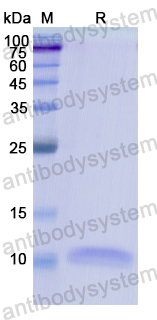Catalog No.
YHD36001
Expression system
E. coli
Species
Homo sapiens (Human)
Protein length
Gly34-Asn107
Predicted molecular weight
10.25 kDa
Nature
Recombinant
Endotoxin level
Please contact with the lab for this information.
Purity
>90% as determined by SDS-PAGE.
Accession
P19875
Applications
ELISA, Immunogen, SDS-PAGE, WB, Bioactivity testing in progress
Form
Lyophilized
Storage buffer
Lyophilized from a solution in PBS pH 7.4, 0.02% NLS, 1mM EDTA, 4% Trehalose, 1% Mannitol.
Reconstitution
Reconstitute in sterile water for a stock solution. A copy of datasheet will be provided with the products, please refer to it for details.
Shipping
In general, proteins are provided as lyophilized powder/frozen liquid. They are shipped out with dry ice/blue ice unless customers require otherwise.
Stability and Storage
Use a manual defrost freezer and avoid repeated freeze thaw cycles. Store at 2 to 8°C for frequent use. Store at -20 to -80°C for twelve months from the date of receipt.
Alternative Names
GROB, CXCL2, Growth-regulated protein beta, Macrophage inflammatory protein 2-alpha, SCYB2, HSF, Gro-beta, Hematopoietic synergistic factor, MIP2-alpha, C-X-C motif chemokine 2, MIP2A, GRO2, SB-251353, GRO-beta-T
USP48 protects against myocardial ischemia-reperfusion injury by stabilizing and upregulating CNN1 in type 1 diabetes mice., PMID:40513941
C-type lectin-like receptor 2 in platelets amplifies inflammation in rheumatoid arthritis., PMID:40486208
Bone, dentin and cementum differentially influence the differentiation of osteoclast-like cells., PMID:40473827
Macrophages generated in 3D mechanical microenvironment contribute to recruiting Peritonitis-associated neutrophils in vivo., PMID:40468354
Huangqi fuling decoction inhibits the invasion and metastasis of gastric cancer via the TNF signaling pathway., PMID:40467576
Single-cell transcriptomics reveals cellular dynamics and chemokine CXCL2-mediated smooth muscle cell proliferation in arterial repair., PMID:40463365
Effects of kidney-tonifying Chinese herbs on thymus regen-eration after rapamycin-induced degeneration in mice., PMID:40461290
Identification of hub immune-related genes and construction of predictive models for systemic lupus erythematosus by bioinformatics combined with machine learning., PMID:40438384
Protective Effect of Obeticholic Acid on Sepsis-Induced Liver Dysfunction via Regulating Bile Acid Homeostasis., PMID:40430579
Screening of Fecal Bacteroides Strains and Discovery of Bacteroides eggerthii S13-F8 with Protective Effects Against Chemotherapy-Induced Diarrhea., PMID:40423879
NLRP3 activation induces BBB disruption and neutrophil infiltration via CXCR2 signaling in the mouse brain., PMID:40413505
The novel compound CP-10 suppresses microglia-mediated neuroinflammation and neutrophil chemotaxis and attenuates ischemic brain injury by targeting FPR1., PMID:40412758
Exercise plasma improves traumatic brain injury outcomes in mice., PMID:40410204
Protective Effects of Octyl Gallate Against Deoxynivalenol-Induced Colon Inflammation: Insights from Proteomic and Metabolomic Analyses., PMID:40400552
POSTN Silencing Ameliorates LL37-Induced Rosacea and Inhibits the JAK2/STAT3 and NF-κB Pathways., PMID:40387439
ATG5 suppresses type I IFN-dependent neutrophil effector functions during Mycobacterium tuberculosis infection in mice., PMID:40374743
Overexpression of SERPINA3 inhibits castration-resistant prostate cancer progression by enhancing M1 macrophage recruitment via CXCL2 upregulation., PMID:40367014
Pharmacological modulation of neutrophils, in contrast to that of macrophages/microglia, is sex independent and delays the development of morphine tolerance in a mouse model of neuropathic pain., PMID:40349556
Monocytes/macrophages contamination disrupts functional and transcriptional characteristics of murine bone marrow- and bone-derived stromal cells., PMID:40329992
The TRPM5 Antagonist Triphenylphosphine Oxide Increases Sebaceous Lipogenesis and Modulates Immune Phenotype of Human Sebocytes in a TRPM5-Independent Manner., PMID:40329688
Galectin-3 suppresses CD8+ T cells function via myeloid-derived suppressor cells recruitment in cervical cancer., PMID:40318724
Augmented hippocampal up-regulation of immune modulators following a peripheral immune challenge in a hemizygous mouse model of the 15q13.3 microdeletion., PMID:40300236
USP14-IMP2-CXCL2 axis in tumor-associated macrophages facilitates resistance to anti-PD-1 therapy in gastric cancer by recruiting myeloid-derived suppressor cells., PMID:40269263
Candidalysin induces Tim-3 expression in macrophages to suppress antifungal immunity in oropharyngeal candidiasis., PMID:40252466
Caspase-6/Gasdermin C-Mediated Tumor Cell Pyroptosis Promotes Colorectal Cancer Progression Through CXCL2-Dependent Recruitment of Myeloid-Derived Suppressor Cells., PMID:40213993
CXCL Gene Clusters Regulated by Enhancer-Mediated DNA Looping Alteration in Pancreatic Cancer Cells., PMID:40194986
Inflammatory markers activation associated with vapor or smoke exposure in Wistar rats., PMID:40191199
The crosstalk of monocyte-neutrophil in hair follicles regulates neutrophil transepidermal migration in contact dermatitis., PMID:40185981
Decoding Colorectal Cancer: Key Genes and Pathways in the Chinese Population Revealed., PMID:40183269
A non-bactericidal glycine-rich peptide enhances cutaneous wound healing in mice via the activation of the TLR4/MAPK/NF-κB pathway., PMID:40164342
Single-cell sequencing uncovers a high ESM1-expression endothelial cell subpopulation associated with bladder cancer progression and the immunosuppressive microenvironment., PMID:40159545
Integrating transcriptomics and network pharmacology to reveal the effect and mechanism of Bai-Jie-Jing-Xie ointment on improving skin inflammation of psoriasis., PMID:40158831
Single-cell sequencing reveals the same heterogeneity of neutrophils in heatstroke-induced lung and liver injury., PMID:40158777
High-Intensity Interval Training Decreases Circulating HMGB1 in Individuals with Insulin Resistance: Plasma Lipidomics Correlate with Associated Cardiometabolic Benefits., PMID:40152388
Microglia-derived CXCL2 induced neuronal ferroptosis via CXCR2/Jun axis in sepsis-associated encephalopathy., PMID:40115159
[Characteristics of Aurora Kinase A-Mediated Tumor Microenvironment in Colorectal Cancer and Mining of Active Compounds From Chinese Herbs]., PMID:40109475
Chemokine (C-C Motif) Ligand 2 Expressing Adventitial Fibroblast Expansion During Loeys-Dietz Syndrome Aortic Aneurysm Formation., PMID:40109260
Langhans giant cells regulate cutaneous immune responses during mycobacterial infection through CXCL1/CXCL2 secretion., PMID:40088869
NLRP4 unlocks an NK/macrophages-centered ecosystem to suppress non-small cell lung cancer., PMID:40087771
Anti-Stress Effects of Tremella fuciformis Berk. Enzymatic Extracts: A Preclinical Study., PMID:40077789
Acute kidney injury triggers hypoxemia by lung intravascular neutrophil retention that reduces capillary blood flow., PMID:40048367
Caffeic acid-vanadium nanozymes treat skin flap ischemia-reperfusion injury through macrophage reprogramming and the upregulation of X-linked inhibitors of apoptotic proteins., PMID:40041895
Activated Microglia Mediate the Motor Neuron-, Synaptic Denervation- and Muscle Wasting-Changes in Burn Injured Mice., PMID:40035088
FGF21, a modulator of astrocyte reactivity, protects against ischemic brain injury through anti-inflammatory and neurotrophic pathways., PMID:40021824
HSPB1 Orchestrates the Inflammation-Associated Transcriptome Profile of Atherosclerosis in HUVECs., PMID:40018940
Transient Lymphatic Remodeling Follows Sub-Ablative High-Frequency Irreversible Electroporation Therapy in a 4T1 Murine Model., PMID:39998766
Identification of Potential Therapeutic Targets Against Anthrax-Toxin-Induced Liver and Heart Damage., PMID:39998071
Unveiling the molecular mechanisms of Haitang-Xiaoyin Mixture in psoriasis treatment based on bioinformatics, network pharmacology, machine learning, and molecular docking verification., PMID:39993869
Dolutegravir induces endoplasmic reticulum stress at the blood-brain barrier., PMID:39985305
FOXC1 promotes EMT and colorectal cancer progression by attracting M2 macrophages via the TGF-β/Smad2/3/snail pathway., PMID:39978609

